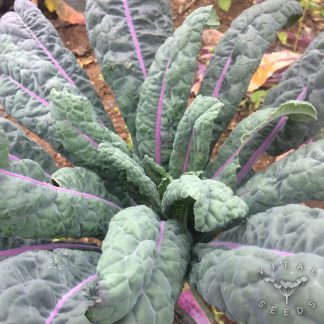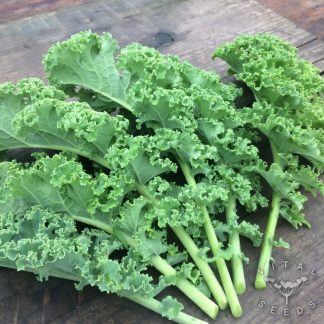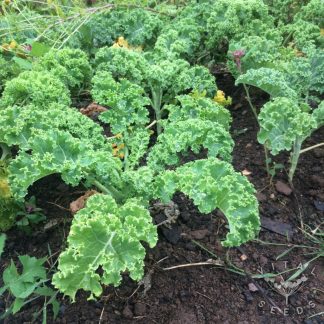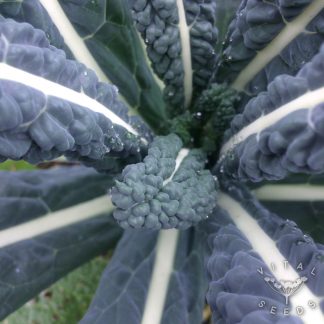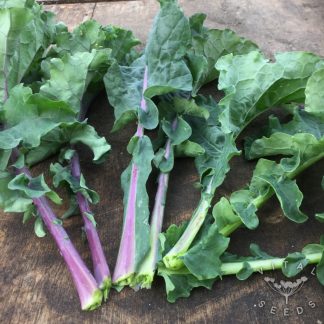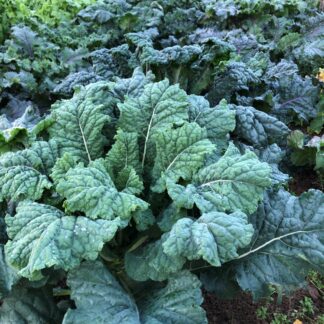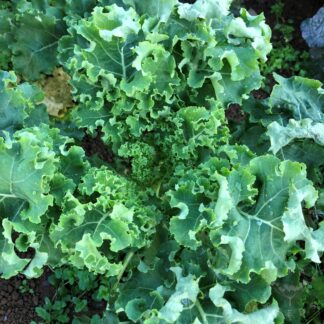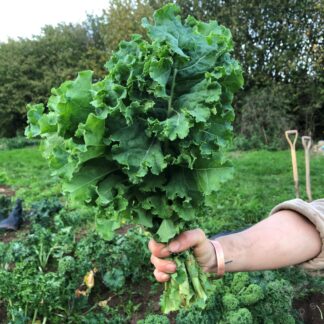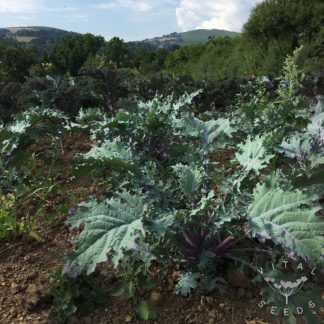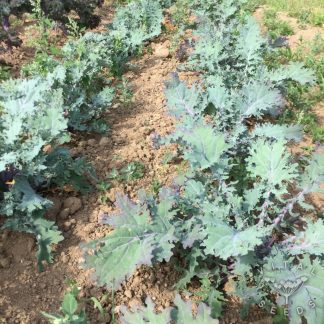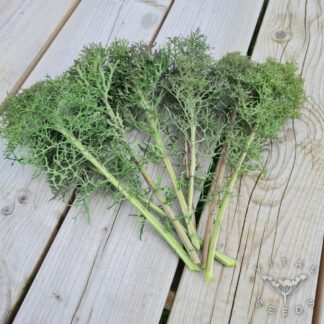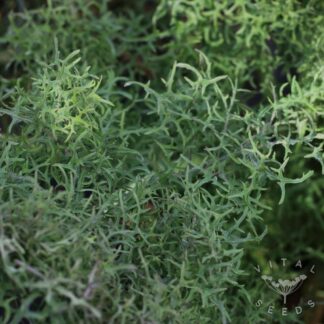Kale Seeds
How to grow kale
How to grow kale
Seed Sowing
Sow kale from March until August undercover in module trays, transplanting into its final growing position after about 4-6 weeks. From May onwards, kale can also be sown directly outside in drills 50cm apart once the soil has started to warm up.Different varieties are suited to different seasons, so check the information on your seed packets to ensure you are sowing them at the correct time of year.
Transplanting
Plant out into final growing position at 50x50cm spacing. Kale plants do not like loose soil, so make sure to bury seedlings right up to their first true leaves and firm in the soil around the plants well.
Protect seedlings with horticultural fleece if planting out before the last frost.
Plant Care
Kale prefers well-draining and fertile soil so be sure to amend your soil with good quality compost or well-rotted manure before planting. You can also use mulch around the base of plants to hold in soil moisture and inhibit weed growth.
Challenges
Horticultural mesh can be used to protect young seedlings from the larvae of cabbage root fly or the caterpillars of cabbage white butterflies. However, once the eggs are laid it can also trap them inside and cause further problems. Keep an eye on your plants to avoid any crop loss. Often opening up the mesh to allow birds to predate the caterpillars or larvae can help to restore the balance.
Birds themselves can also become a problem in the winter months and horticultural mesh can be used to protect your crops. The risk of club root can be reduced by making sure you follow a rotation in your garden beds and leave sufficient time in between brassica crops.
Risks of fungal disease can also be reduced by spacing out plants correctly and making sure to remove dead or decaying leaves from around the base of the plants.
Harvest
Depending on the variety, kale can either be harvested as a cut and come again crop by removing the bottom leaves or cut as tender, young leaves for salads.
Winter hardy varieties of kale stand up well to cold temperatures and can be harvested throughout the winter months. Side-shoots may form in February or March after the main crown has been harvested and are delicious alternatives to sprouting broccoli.
Seed Saving
Kale belongs to the species Brassica oleracea and will cross with all other plants within it. If you want to save seed from kale, make sure that no other brassicas of this species are allowed to flower. Kale for seed is best grown in a block of at least twelve plants – make sure to choose plants that are true to type, are healthy and have shown disease resistance.
Allow plants to flower and then begin to dry, then cut the whole plant and mature further on a sheet indoors. When fully dry the seeds will fall out of the heads very easily. You can stand on the plants to break up the seed heads and then sieve out the debris.
 Growing suggestions for kale seeds
Growing suggestions for kale seeds
Sow kale seeds from March in modules/pots and transplant after 4-5 weeks. Make sure to plant right up to the first true leaves and ‘firm-in’ in the plants well when planting – they will not be happy in loose soil. Alternatively direct sow outdoors from May in drills 50cm apart and thin to final spacing. Thinnings are a delicious addition to salad.
Crop History
Kale has been known and grown for over 2,000 years. It has many names in many languages, as a result of its great antiquity and widespread use. The cultivation of this leafy vegetable of the mustard family (Brassicaceae) was encouraged during World War II because it provided vital nutrients and was available to supplement rationing as it is easy to grow. Not least has it recently been considered a ‘super food’ because the nutrients in kale can help boost well-being and prevent a range of health problems.
Growing calendar
| Month | J | F | M | A | M | J | J | A | S | O | N | D | ||||||||||||
|---|---|---|---|---|---|---|---|---|---|---|---|---|---|---|---|---|---|---|---|---|---|---|---|---|
| Sow | ||||||||||||||||||||||||
| Plant | ||||||||||||||||||||||||
| Harvest | ||||||||||||||||||||||||
Showing all 7 results
-


Kale – Dazzling Blue (Organic)
Price range: £2.85 through £4.00 Add to basket This product has multiple variants. The options may be chosen on the product pageKale – Dazzling Blue (Organic)
Cavolo Nero-type kale of dazzling blue and green coloured leaves with exceptional pink midribs. This showy kale was bred by Hank Keogh from Avoca Farm in Oregon, USA. He back-crossed ‘Lacinato rainbow’ with the Wild Garden Seed ‘Lacinato’. In looks it resembles a Cavolo Nero kale and it has stunning blue, green and pink colours. The leaves are savoyed and have underturned margins, the plant grows upright and is very cold-hardy – more so than any other Cavolo Nero type kales. Tender and tasty, great for sautéing, steaming or finely chopped in a salad. A solid vegetable for the home or market garden.
 Price range: £2.85 through £4.00
Price range: £2.85 through £4.00 -


Kale – Dwarf Green (Organic)
£2.10 Add to basketKale – Dwarf Green (Organic)
A hardy kale with a compact growth habit and tightly curled leaves. A deep green leaf colour and frilled edges with a succulent delicate flavour make this variety an attractive kale to grow. It is extremely hardy and withstands frosts in the winter when no other brassica stays standing while also producing well when sown in spring for a summer harvest. It is a Scottish heritage kale dating back to the 19th century, originally known as ‘Dwarf Curlies’ or ‘Scotch’ kale. It grows to only 40cm high making it perfect for windswept sites or for growing in containers.
(Approximate seed count – 150) £2.10
£2.10 -


Kale – Nero di Toscana (Organic)
Price range: £2.50 through £3.50 Add to basket This product has multiple variants. The options may be chosen on the product pageKale – Nero di Toscana (Organic)
Upright plants producing lots of heavily savoyed dark green leaves. Surely this is the king of kales! We always grow masses of Nero di Toscana, we cant get enough of it. It has been a staple of Italian cuisine for centuries and heavily features in the iconic ‘Ribollita’ Tuscan bean stew.
Although usually steamed or stir-fried, kale leaves can also be massaged raw with a little olive oil, salt and lemon juice and made into a salad. Well worth a try if you haven’t already!
(Approximate seed count – 150) Price range: £2.50 through £3.50
Price range: £2.50 through £3.50 -


Kale – Tuscan Rainbow (Organic)
Price range: £2.30 through £4.80 Add to basket This product has multiple variants. The options may be chosen on the product pageKale – Tuscan Rainbow (Organic)
Red, purple and blue-green leaf colours with slight ruffling on the edges, cold resistant and vigorous. A Frank Morton cross from Wild Garden Seed in Oregon, USA of Cavolo Nero ‘Lacinato’ and Redbor hybrid kale. The majority of the plants have savoyed, blue-green leaves with ruffled edges, others are more purple or more white, some have more ruffling and others less. When grown outdoors the colours will intensify with the cold. It is a hardy and very beautiful kale tasting. sweet and aromatic.
We planted ‘Lacinato rainbow’ in our 2018 trial and relished in this diverse variety that tastes amazing and is more funky and cold-resistant than the usual Cavolo Nero
 Price range: £2.30 through £4.80
Price range: £2.30 through £4.80 -


Kale – Pentland Brig (Organic)
£2.10 Add to basketKale – Pentland Brig (Organic)
Pentland Brigg or Pentland Brig (Scottish for Bridge) is a superb heritage kale which is the result of a cross between Dwarf Green and Thousand Headed kale. With parents such as these it’s no wonder this is such a great variety.
In form it is very much in between it’s parents, being slight less curled than Dwarf Green but more curled than Thousand Headed. It is extremely cold hardy and produces an abundance of sweet and delicious shoots in the spring which can be eaten like sprouting broccoli (known as kale raab).
Growth height 60cm
(Approximate seed count – 150) £2.10
£2.10 -


Kale – Red Russian (Organic)
Price range: £2.10 through £4.40 Add to basket This product has multiple variants. The options may be chosen on the product pageKale – Red Russian (Organic)
Recognisable by its flat, purple-tinged and tooth-shaped leaves; this kale is hardy, frost tolerant and very versatile. A productive plant, it reaches 90cm in height and can be harvested throughout the winter becoming sweeter after a frost. The tender young leaves are great in salads and larger leaves are attractive as well as delicious. This kale is so tasty you can eat it on its own, but it’s also a perfect addition to smoothies, salads and stir fries. You can get in the habit of adding it to most meals! In Scotland, kale used to be a mainstay of the traditional diet. So much so that to be “off one’s kail” means to feel too ill to eat.
 Price range: £2.10 through £4.40
Price range: £2.10 through £4.40 -


Kale – Bear Necessities (Organic)
Price range: £2.10 through £4.00 Add to basket This product has multiple variants. The options may be chosen on the product pageKale – Bear Necessities (Organic)
An unusual ultra-frilly Red-Russian type. Bear Necessities has leaves unlike any other kale as it was bred from a cross between a mizuna and a kale. It’s ultra frilly leaves lend themselves to salads when young and are great cooked when larger.
The leaves have a high volume and surface area which means they stir-fry particularly well, easily getting coated in delicious flavours and holding their shape.
 Price range: £2.10 through £4.00
Price range: £2.10 through £4.00
Showing all 7 results

